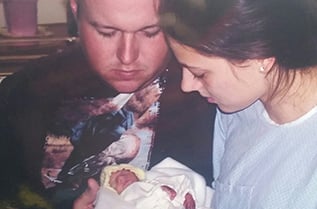
Gracelyn Ford changed her family forever through her very brief 13 and a half-hours of life. Gracelyn was born in 2015 with anencephaly, a birth defect in which the brain and skull do not fully form. The condition is lethal, often before or at delivery.
“I got a call from my OBGYN that my fiancé and I needed to come in because something came back on my blood work,” recalls Gracelyn’s mother, Samantha Hicks.
After a two-week wait to see a maternal fetal medicine specialist, Samantha and her fiancé, Trey Ford, received the devastating news that their precious baby had anencephaly.
Anencephaly is a neural tube defect, the most severe of a group of birth defects affecting the developing brain and spine.
“Neural tube defects, such as anencephaly, occur very early in a pregnancy, before most women even know
they are pregnant,” shared
Jane Dean, RN, Statewide Coordinator of the SC Birth Defects Prevention Program at the Greenwood Genetic Center.
Samantha and Trey made the decision to carry the pregnancy to term.
“I did not let the news of her condition dull my pregnancy with her, I knew as long as I was breathing, so was she,” said Samantha. “I could feel her moving and kicking just like any normal pregnancy, it was very hard to face the fact that she would die soon after I had her.”
Samantha was induced and delivered 5 pound 3 ounce Gracelyn the following day. Trey, Samantha and their families had 13 and a half hours with their precious baby. “She beat the odds,” said Samantha. “She was supposed to die before birth or be stillborn, but she made it.”
“The good news about neural tube defects is that most of them are preventable,” said Dean. “Women who take folic acid, a B vitamin, prior to and during the first months of pregnancy dramatically lower their risk of having a baby with one of these defects.”
The Prevention program, in existence since 1992, has led to a 60% decrease in neural tube defects in SC by educating healthcare providers and women of childbearing age of the importance of taking folic acid.
“It’s very difficult to make sure to get enough folic acid in our diet, so we recommend that women take a supplement of 400 micrograms a day during their childbearing years, even if not planning a pregnancy,” shared Dean.

Samantha began taking prenatal vitamins as soon as she found out she was pregnant, but unfortunately that was too late.
“After we lost Gracelyn, God answered my prayers with another baby,” said Samantha. “I took folic acid and prenatal vitamins, and of course I was extremely nervous until we saw her perfect skull and her spine on ultrasound.”
Gracelyn’s sister, Taelyn Grace Ford, was born the following year.
“We honor Gracelyn’s memory with pictures of her all over the house,” shared Samantha. “I tell her sister about her every day!”
Photos courtesy of Samantha Hicks
For more information, contact Lori Bassett
